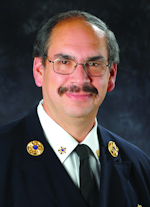With November being our focus on the latest fire apparatus, I would like to reflect on some of the many factory visits I had made over the years. A few months ago, I was asked to visit Pierce in Wisconsin. The company was showing the fire service media a new design in apparatus. The new rig has plenty of room upfront for the driver and officer, and the crew cab has an unobstructed view throughout. I made the comment that in my departments, when personnel are available, we may have six members riding on a rig. I was told that most departments interested in the design were riding three or four, on average across the nation. Since the early 1980s, I’ve visited the following apparatus manufacturers: Hahn, Grumman, Saulsbury, Seagrave, E-ONE, Rosenbauer and now Pierce. When I was at the latest New Jersey State Fireman’s Convention in Wildwood, a demonstrator rig was traveling along the East Coast. It is always a thrill to see new, technologically superior apparatus incorporating the latest safety, ergonomics and firefighting capabilities from all of the manufacturers.
When great minds get together to ask firefighters what they think about apparatus, what kinds of innovations they want to see, how their jobs can be made easier and safer and how manufacturers can provide a more comfortable ride, the results can be amazing. We’ve come a long way from hand-drawn, horse-drawn, motorized and now fully enclosed crew cabs. What will tomorrow bring?
This month, three features assess today’s apparatus market: our annual Apparatus Showcase on page 52, The Apparatus Architect on page 66 and a Manufacturers Roundtable on page 72.
• • •
Recently, I was invited by Underwriters Laboratories (UL) to serve on a project advisory committee regarding the effectiveness of fire service ventilation and suppression tactics. This follows work last year on horizontal ventilation. Under the U.S. Department of Homeland Security (DHS) Assistance to Firefighter Grant (AFG) Program – Fire Prevention and Safety Grants, UL is examining the impact of vertical ventilation (through the roof), both naturally induced and as a firefighting tactic, on fire-growth behavior in residential structures. This two-year project will develop empirical data on vertical-ventilation techniques that is needed to quantify the fire behavior associated with these scenarios and result in immediately developing the necessary firefighting ventilation practices to reduce firefighter death and injury. Suppression techniques used to fight these modern fire conditions will also be examined to assess their impact on occupant survivability. This fire research project will further work from previous DHS AFG-sponsored research (EMW-2008-FP-01774), which studied the impact of horizontal ventilation through doors and windows. Additionally, this research will address questions of smoke-alarm response associated with different alarm technologies and alarm location to support fire department smoke-alarm distribution programs, including those sponsored by DHS Fire Prevention and Safety Grant program. The project objectives are as follows:
• Improve firefighter safety by increasing knowledge of fire behavior
• Develop knowledge of vertical-ventilation tactics
• Generate understanding of modern construction practices such as open floor plans and emerging attic construction design on fire growth
• Address concerns about smoke-alarm technologies and placement to support fire department smoke-alarm distribution programs
• Develop tactical considerations based on the experimental results that can be incorporated into firefighting standard operating guidelines (SOGs)
As the two-year plan continues, we will report on updates as they become available.
• • •
As we get closer to Firehouse World 2012, Feb. 19-23 in San Diego, CA, we have added timely topics involving the current economic climate, the survival of the fire service as we know it and firefighter safety. Recently added classes include Near-Miss Incidents; The Complete Fire Officer; A Major Safety Investigation; Preparing for the International City Managers’ 20 Tough Questions; The Future of Your Fire Department; A Company Officer’s Guide to Fire Service Politics; Group Purchasing: Save Time and Money; and Shots Fired! Are You Ready? See www.firehouseworld.com.
• • •
FOR COMMENTS AND SUGGESTIONS, please contact us at [email protected].

Harvey Eisner | Editor Emeritus
HARVEY EISNER was named Editor Emeritus of Firehouse® after serving 15 years as Firehouse's Editor-in-Chief. He joined the Tenafly, NJ, Fire Department in 1975 and served as chief of department for 12 years. He was a firefighter in the Stillwater, OK, Fire Department for three years while attending Oklahoma State University. Eisner was an honorary assistant chief of the FDNY and program director for the Firehouse Expo, Firehouse World and Firehouse Central conferences. He covered many major fires and disasters and interviewed numerous fire service leaders for Firehouse®







